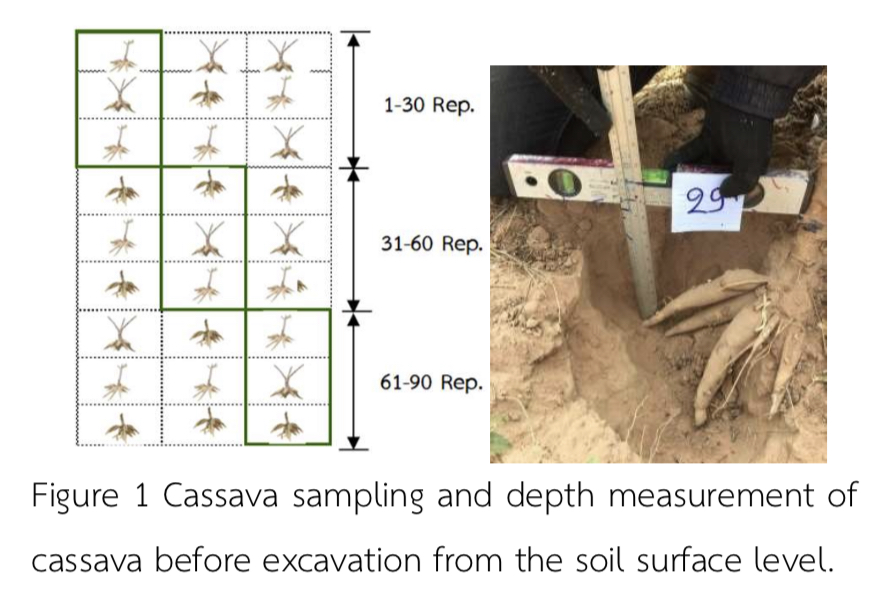การลดความสูญเสียในการเก็บเกี่ยวหัวมันสำปะหลังด้วยวิธีการถ่วงน้ำหนักที่ตำแหน่งผานขุดแบบจานโค้งชนิดติดท้ายแทรกเตอร์ Reduction of Cassava Tuber Loss during Harvesting by Weight Addition on a Curved-Plate Digger Mounted to a Tractor.
Main Article Content
บทคัดย่อ
This experiment aims to study the losses reduction in cassava roots harvesting by using a curved plate ploughed type (attached to a tractor) to increase weight at the position of the digging disc. The data collection was conducted at a cassava field planted with Kasetsart 50 variety and harvested at age 8. The planting and harvest methods were followed the conventional methods practised by farmers at Kalasin, Thailand. This study investigated the physical properties of cassava rhizome before digging, the depth of digging curved plate without weight (typical depth of digging used by the farmer) and the depth of digging curved plate attached with 50 kg. weight. The results showed that the depth of cassava roots buried beneath the soil surface has a mean value of 20.97 cm, the highest value 29.30 cm, and the lowest value 14.50 cm. The depth of digging curved plate without weight has a mean value of 19.07 cm, covering the depth of cassava roots beneath the soil surface in the field, 48.89 %. The harvest by adding weight at the digging disc increases the depth of digging curved plate 3.13 cm. or equal to the total depth of digging curved plate 22.20 cm, which cover the depth of cassava roots beneath the soil surface of the field, 81.11 %. Thus, adding weight at the position of the digging disc reduces the losses in cassava harvesting by 0.99 %, which improves the effectiveness of harvesting and income for farmers in an average of 117.56 Bath. Rai-1
Article Details

อนุญาตภายใต้เงื่อนไข Creative Commons Attribution-NonCommercial-NoDerivatives 4.0 International License.
สมาคมวิศวกรรมเกษตรแห่งประเทศไทย
Thai Socities of Agricultural Engineering
เอกสารอ้างอิง
คุรุวรรณ์ ภามาตย์, โสภิตา สมคิด, และ อนุชิต ฉ่ำสิงห์. 2556.
ทดสอบ และพัฒนาเครื่องขุดมันสำปะหลังให้เหมาะสมกับ
พื้นที่ในเขตภาคตะวันออก.แหล่งข้อมูล: https://kukr. lib.
ku.ac.th/db/index.php?/BKN/search_detail/result/13
ไทยเกษตรศาสตร์. ม.ป.ป. เครื่องสับใบและเศษซากอ้อย. แหล่งข้อมูล: https://www.thaikasetsart.com/
มิตรผลโมเดิร์นฟาร์ม. 2563 .บำรุงอ้อยตอด้วยการพรวนหลังตัด. แหล่งข้อมูล: http://www. mitrpholmodernfarm. com/
news/2020/12
มูลนิธิสถาบันพัฒนามันสำปะหลังแห่งประเทศไทย ในพระราชูปถัมภ์สมเด็จพระเทพรัตนราชสุดาฯ สยามบรมราชกุมารี. ม.ป.ป. ระยะเวลาเพาะปลูก. แหล่งข้อมูล: https:// tapiocathai.org/pdf/Tapioca%20Plan/g_planting%20period.pdf
ศูนย์วิจัยมันสำปะหลังและผลิตภัณฑ์ มหาวิทยาลัยเทคโนโลยีสุรนารี. ม.ป.ป. .มันสำปะหลังพันธุ์ใหม่ สำหรับปลูกปลายฝน. แหล่งข้อมูล: http://web.sut.ac.th/cassava/index. php?name=11cas_esearch&file=readknowledge&id=62
วินิต ชินสุวรรณ. 2530. เครื่องจักรกลเกษตรและการจัดการเบื้องต้น. ภาควิชาวิศวกรรมเกษตร คณะวิศวกรรมศาสตร์ มหาวิทยาลัยขอนแก่น.
เสรี วงส์พิเชษฐ และ พิศาล หมื่นแก้ว . 2556. การเก็บเกี่ยวมันสำปะหลังในประเทศไทย. แหล่งข้อมูล: https://www. phtnet.org/2013/06/131/
สมนึก ชูศิลป์. 2537. การออกแบบและพัฒนาเครื่องขุดมันสำปะหลัง. (แผ่นพับ). กรุงเทพฯ: สำนักส่งเสริมและถ่ายทอดเทคโนโลยี กระทรวงวิทยาศาสตร์ เทคโนโลยีและสิ่งแวดล้อม.
เสรี วงส์พิเชษฐ. 2551.การวิจัยและพัฒนาเครื่องขุดมันสำปะหลังโดยใช้รถไถเดินตามเป็นต้นกำลัง. (รายงานการวิจัยฉบับสมบูรณ์). ศูนย์นวัตกรรมและเทคโนโลยีหลังการเก็บเกี่ยว มหาวิทยาลัยขอนแก่น.
เสรี วงส์พิเชษฐ และสมนึกชูศิลป์. 2548. การพัฒนากระบวนการเก็บเกี่ยวมันสำปะหลังด้วยเครื่องขุดมันสำปะหลัง. (รายงานการวิจัยฉบับสมบูรณ์). คณะวิศวกรรมศาสตร์ มหาวิทยาลัยขอนแก่น.
สำนักงานเศรษฐกิจการเกษตร. 2563. มันสําปะหลังโรงงาน : เนื้อที่เพาะปลูก เนื้อที่เก็บเกี่ยว ผลผลิต และผลผลิตต่อไร่ แยกตามชนิดพันธุ์ ระดับจังหวัด. แหล่งข้อมูล: https://www. oae.go.th/assets/portals/1/fileups
/prcaidata/files/varitties%20casava63.pdf
สำนักงานเกษตรและสหกรณ์ จังหวัดพะเยา. 2563. มันสำปะหลังจังหวัดพะเยา ปี 2563. แหล่งข้อมูล: https://www.opsmoacgothphayao-dwl-preview
-421491791913
อนุชิต ฉ่ำสิงห์, อัคคพล เสนาณรงค์, สุภาษิต เสงี่ยมพงศ์, พักตร์วิภา สุทธิวารี, ยุทธนา เครือหาญชาญพงค์, ขนิษฐ์ หว่านณรงค์ และประสาท แสงพันธุ์ตา. 2551. วิจัยและพัฒนาเครื่องขุดมันสำปะหลังแบบไถหัวหมู.ผลงานวิจัยและพัฒนา ปี 2551.กลุ่มวิจัยวิศวกรรมผลิตพืช สถาบันวิจัยเกษตรวิศวกรรม. แหล่งข้อมูล: https://www.doa.go.th/ research/showthread.php?tid=1510
Amponsah, Shadrack Kwadwo. 2011. Performance evaluation of the TEK mechanical cassava harvester in three selected locations of Ghana. Available at: http://ir.knust.edu.gh/handle/123456789/3960
E. Y. H. Bobobee, J. B. Okyere, W. A. Agyare, S. K. Amponsah, S. R. King, J. Aveyire & J. Sarkodie-Addo. 2014. Performance evaluation of prototype mechanical cassava harvester in three agro-ecological zones in Ghana. Available at: https://www.ajol.info/index. php/gjas/article/view/116239
K. Pradeep Kumar, Vaishali. V, Lakshmi Priya. B, Mohamudha Jumana Hasin. A & Logeshwaren. T. 2021. Hydraulic Cassava Harvester. Available at: https://www.irjet.net/ archives/V8/i3/IRJET-V8I3551. pdf
Shadrack Kwadwo Amponsah, Joseph Nketiah Berchie, Joseph Manu-Aduening, Eric Owusu Danquah, Jonas Osei Adu, Adelaide Agyeman & Enoch Bessah. 2017. Performance of an improved manual cassava harvesting tool as influenced by planting position and cassava variety. Available at: https:// academic


